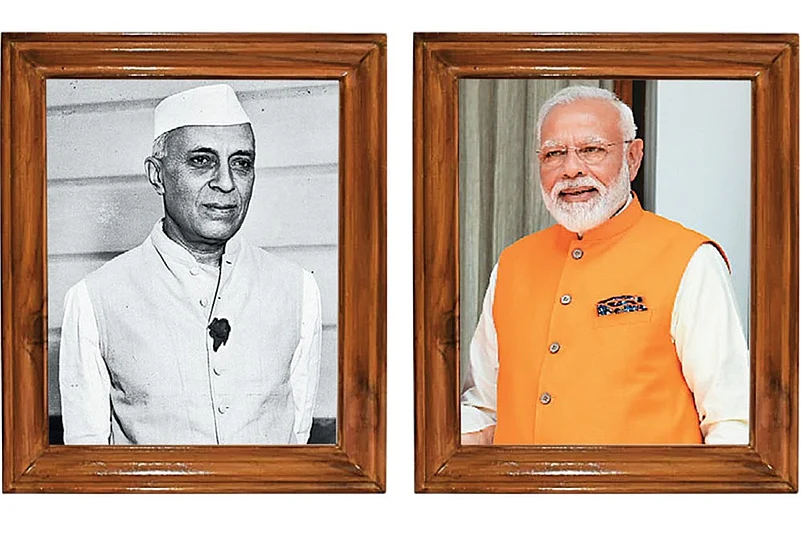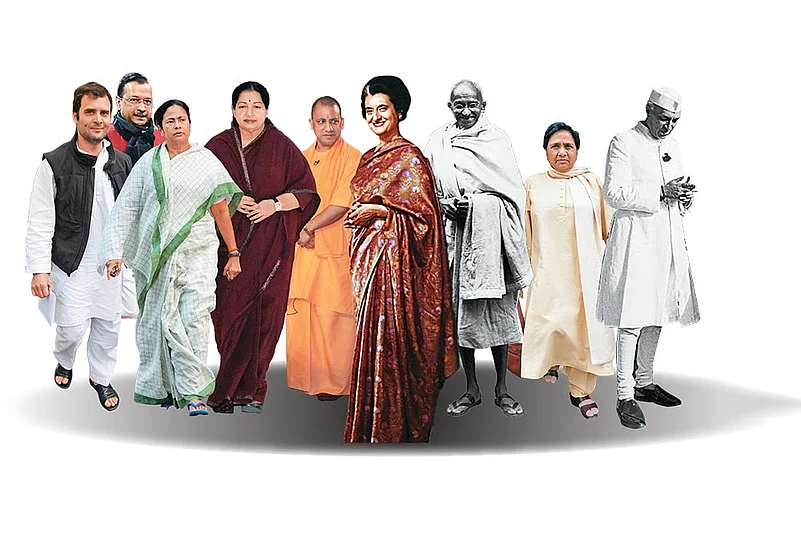When Narendra Modi went on an official tour to China at the start of his first term as prime minister, the photos released on his feed went viral. A stylishly dressed Modi—sporting kurtas, churidars, desi jackets, and swanky sunglasses shot selfies with the Chinese premier Li Keqiang; posed for pictures indoors and under bright blue skies. Modi’s selfie with Li Keqiang got over 31 million hits on Weibo. When Modi moved on to Mongolia, he was photographed wearing a long, flowing Mongolian robe, with a fedora perched on his head. As photos poured in, a leading Indian newspaper gushed: “Move over Tom Cruise. Modi is the new Top Gun.”
From Saffron To Dhoti, The Emperor's New Clothes
Politicians use a carefully constructed dress sense to send out targeted messages and build a distinct image.

Since then, the spotlight has never stopped shining on the prime minister’s wardrobe. His collection of hats has been written about countless times. The short-sleeved kurta he sported regularly was christened the Modi kurta. Commenting on his dress sense, the hard-to-please New York Times fashion blog declared: “Mr Modi stands out. Literally and strategically”.
Anyone who reads a newspaper or magazine or browses the Internet knows by now that the nationalist leader prefers traditional clothing made of typically Indian materials—silk and cotton. The PM’s watch may be Movado and his glasses, Bvlgari, but his clothes display his Indian roots. Costume designer and screenplay writer Shama Zaidi says Modi has a “natural inclination” for clothes. “His outfits are impeccably tailored,” she points out, “and the way he dresses often makes other politicians around him look sloppy.”
***

Clothing has always been a crucial prop of political theatre. Sending out targeted messages via clothes, building an image and an identity through a carefully constructed dress sense—many Indian and global leaders have savvily chanelled the power of fashion. “But Modi and his team take it to a whole new level,” says actor and theatre director Sudhanva Deshpande. “Every message he sends out through his clothes is super-calculated. When he visited temples in south India recently, he wore different outfits at each temple to appeal to the constituency there. When he is with industry leaders, he dresses like a modern statesman. Modi wore a dhoti to the inauguration of the new Parliament building last May. When he prostrated before the sengol, I noticed he was wearing long socks so his calves would not be exposed when the cameras clicked.”
No choice is impulsive. Neither outfits nor colour palettes are picked on a whim. During his stint as Gujarat chief minister, bright colours used to be part of Modi’s wardrobe. When he became prime minister, pastels and light shades edged out the bright hues. Saffron, especially muted variations of it, remains a staple. Green, a colour closely associated with Islam, never makes an appearance on the spectrum.
“The PM has a good understanding of traditional Indian textiles,” says Ashima Tiwari, associate professor, department of textile design, National Institute of Fashion Technology (NIFT), Delhi. “He uses their variety to add flavour to his wardrobe. When he visits a state, he wears something specific to that region. For example, for a Rajasthan visit, he chose leheriya [Rajasthani tie and dye]; at Uttarakhand, he wore a traditional ranga and a turban from the hill state. At the Republic Day parade, he goes for turbans from different Indian states, draped in the styles of those states. His clothes send out the message that he respects the traditions and culture of each place. Many people connect to that.”
During a visit in October 2022 to poll-bound Uttarakhand, Modi was photographed wearing four different outfits within eight hours. When he donned a monogrammed suit (decorated with his own name multiple times) said to cost around a million rupees to a meeting with US President Barack Obama in 2015, political rivals were quick to question the extravagance involved. The suit was later auctioned off at Surat to a diamond merchant. It is now enshrined in the Guinness World Records as the “most expensive suit sold at auction”.
The cost of the PM’s sartorial choices has often invited comment. Samajwadi Party founder Mulayam Singh Yadav once quipped, “He [Modi] changes 500 kurtas a day and wears a new kurta to every meeting.” During a press meet, Delhi chief minister Arvind Kejriwal alleged that the PM’s clothes cost more than the Delhi government’s annual advertising budget. “Modi never repeats his clothes,” remarked Kejriwal. “You just have to Google him…You will never find a picture of the same dress again.”
***
In politics, where public perception can build or break a leader’s career, the choice of clothing is serious business. “This is what I wear, therefore, this is who I am,” says the politician. Simplistic as it sounds, voters often tend to buy into it. Clothes can reinforce a message, endorse the wearer’s ideology, and declare loud and clear to the world what the wearer believes in. US Congresswoman Alexandria-Ocasio Cortez (AOC), whose clothes and makeup choices proudly flaunt her Latino identity, posted on Instagram recently: “Dress is a form of communication. Whether one likes it or not, the way one dresses sends many messages at once.” So, it follows that the politician who crafts and controls messages best stays ahead of the pack.
“Months of planning go into preparing PM Modi’s outfits for public appearances,” says Ashima Tiwari. “Everything is thought through: what additions will incorporate flavour and bring a touch of dignity; what details will build deeper connections with people; do the clothes stand out or have others worn the same kind of outfits before…The PM leaves his competitors behind because he pays so much attention to detail.”

Leaders everywhere (barring megalomaniacs like Hitler and Mussolini who dressed in military uniform) are keen to build connections with their constituents. So, a majority of male Indian politicians tend to wear kurta-pyjama and khadi—or linen—jackets, and women leaders drape a saree at public events. An outfit is not just an outfit. It is “instant language” that ignites an emotional response, woos voters, helps win elections. Former prime minister Indira Gandhi, who was considered a universal style icon, preferred to wear woven cotton and silk sarees sourced from all across India. “Her sarees had simple colours, subtle borders,” says seasoned textile designer Neeru Kumar. “She was elegance personified.” Kumar also likes Sonia Gandhi’s choice of handloom sarees and Priyanka Gandhi Vadra’s experimental style. “Rahul Gandhi dresses in everyday clothes,” adds Kumar. “A relatable politician, he never makes a splash about what he’s wearing.”
Another leader whose style choices get Kumar’s vote is West Bengal chief minister Mamata Banerjee. Mamata wears simple white cotton sarees with thin borders in all colours except red—a shade too closely linked to the Communist Party for her comfort. Dressed in sarees woven by Bengal’s weavers, feet clad in Hawai chappals, Mamata walks among the people, paying no heed to PR managers and posh stylists. Former chief minister of Uttar Pradesh Mayawati opts for salwar kameezes in pale colours (barring Brahminical white). Her clothes and accessories are meant to reflect Dalit aspiration and dignity: the handbag she carries is the mark of a modern professional, a repudiation of the humiliating servitude inflicted on her community throughout history; her pricey diamond earrings a nod to Dalit upward mobility.
Former Tamil Nadu Chief Minister J Jayalalithaa used to wear simple south silk sarees and printed satins. This was a fuss-free, functional wardrobe designed specifically to make people forget her glamorous past as a film star and embrace her political avatar. The cape she wore over her sarees too sent out a specific message. It was a reminder of the violence she faced in the state Assembly in 1989 when a few DMK members attacked her in public and tore her saree.
Arvind Kejriwal appeals to his sizeable middle-class voter base by dressing down. No flashy shirts and sweaters, no smartly tailored jackets; and a muffler that has inspired a thousand memes. Like Evo Morales, the labour leader who served as Bolivia’s president from 2006-19, Kejriwal’s clothes are a physical representation of his brand of politics. Morales’ style was once hailed as the “fashion of the populist”. The inexpensive striped sweaters he wore became so popular that Bolivian stores launched an “Evo Line” to satisfy public demand.
“Jawaharlal Nehru was a natty dresser,” says Shama Zaidi. “He had his jacket and signature red rose. During his South Africa days, Gandhi-ji used to wear well-cut suits. He changed his style of dressing after he returned to India because he wanted to connect with the masses.” Gandhi’s clothes expressed his close association with and empathy for the poor and the working class. He chose to travel in third-class compartments, live and dress frugally. “Mahatma Gandhi wore a loin cloth and a khadi dhoti, and he went around bare-chested. The only accessory he had was his watch,” says Sudhanva Deshpande. “He was having a conversation with people through his clothes.”
(This appeared in the print as 'The Emperor's New Clothes')
-
Previous Story
 RG Kar Row: Fasting Unto Death, Medics Attending 'Most Disappointing Meeting' With State Officials | Top Points
RG Kar Row: Fasting Unto Death, Medics Attending 'Most Disappointing Meeting' With State Officials | Top Points - Next Story


















